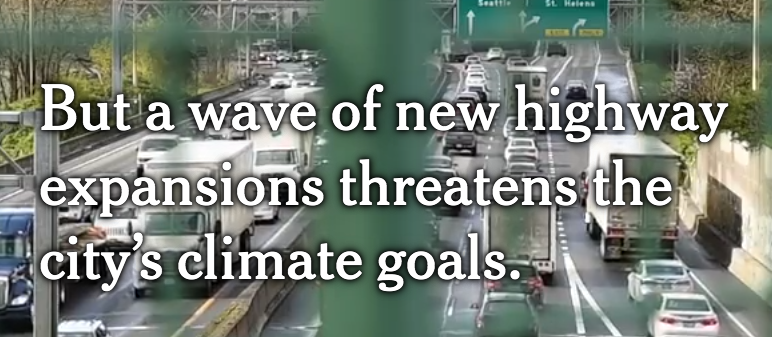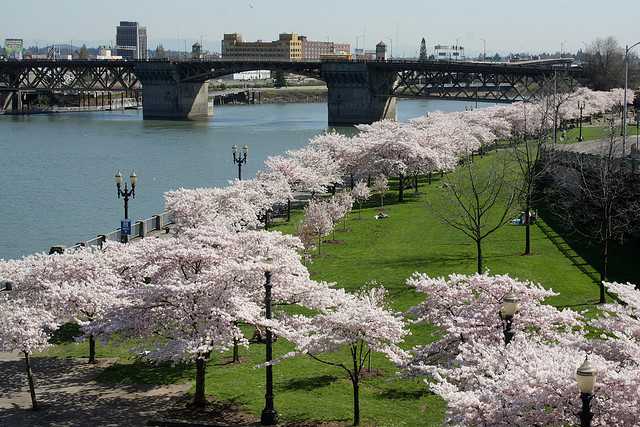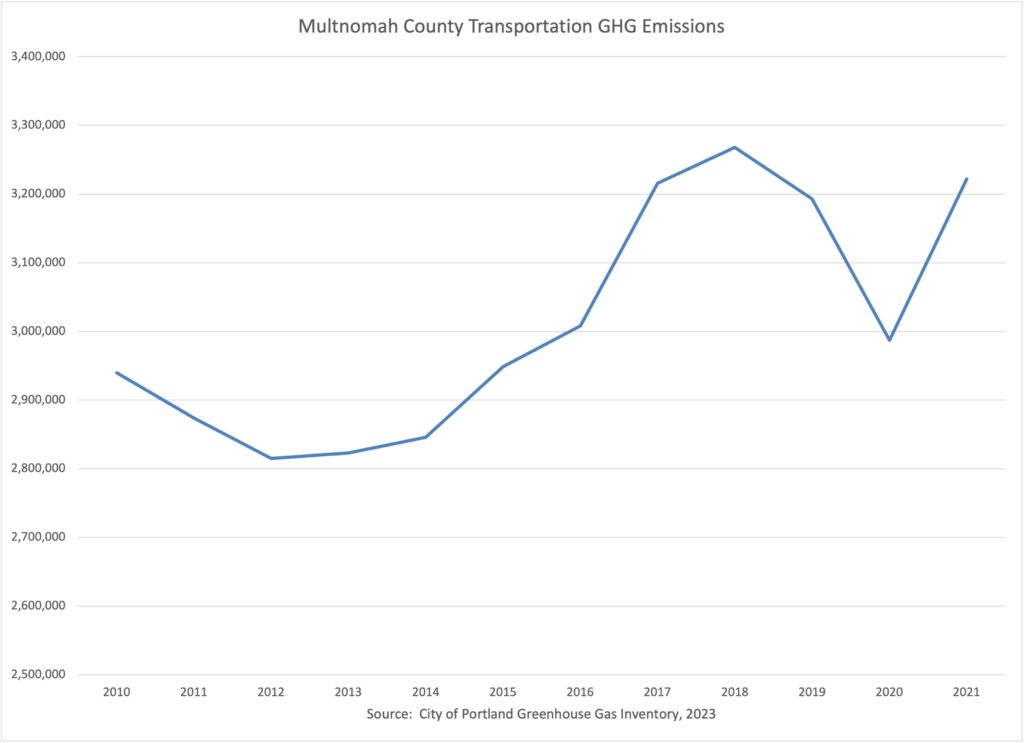Despite legal pledges to reduce greenhouse gases to address climate change, Portland’s transportation greenhouse gas emissions are going up, not down.
State, regional and city governments have adopted climate goals that purport to commit us to steadily reducing greenhouse gases, but we’re not merely failing to make progress, we’re going in the wrong direction.
April 22 is Earth Day, and to celebrate, Oregon is moving forward with plans to billions dollars into three Portland area freeway widening projects. It isn’t so much Earth Day as a three-weeks late “April Fools Day.”
If you’re serious about dealing with climate change, the last thing you should do is spend billions widening freeways.
An Abject Failure to Reduce Emissions from Driving
All of the objective data on greenhouse gas emissions shows we’re failing to meet our stated and legally adopted climate goals, chiefly because transportation emissions are increasing, and we’re driving more. Since 2013, transportation greenhouse gas emissions in Multnomah County have increased by 14 percent from x.x million tons per year to y.y million tons per year according to the City of Portland’s latest emissions inventory. Transportation greenhouse gases declined during the pandemic, but have rebounded, and are now higher than in 2019.
The City’s inventory also shows that per capita transportation greenhouse gas emissions have increased, from 3.7 tons per capita in 2013, to 4.0 tons per capita in 2021. Compared to the promises made to reduce greenhouse gases at a rate of nearly 2 percent per year in spelled out in the city’s 2015 Climate Action Plan, we’re not merely failing to make progress, we’re going rapidly in the wrong direction.
Two years ago, a New York Times story asked the question, “Can Portland be a climate leader without reducing driving?” The Oregon Department of Transportation is answering that question with an emphatic “No.” In the face of increasing driving and greenouse gas emissions, its planning a multi-billion dollar series of highway expansion projects that will only further increase greenhouse gas emissions. That’s how they really celebrate Earth Day..

The Oregon Department of Transportation’s plans to squander billions of dollars widening area highways plainly undermines State, regional, and city commitments to reducing greenhouse gas emissions. Driving is the single largest source of climate pollution in Portland, and it has grown 20 percent, by more than a million tons per year, in the past five years.
Betraying Portland’s Legacy of Environmental Leadership
Nearly five decades after the city earned national recognition for tearing out a downtown freeway, it gets ready to build more. Back in the day, Portland built its environmental cred by tearing out one downtown freeway, and cancelling another–and then taking the money it saved to build the first leg of its light rail system. In place of pavement and pollution, it put up parks. Downtown Portland’s Willamette riverfront used to look like this:

Now the riverfront looks like this:

For decades, city and state political leaders have celebrated this legacy, and proudly touted our environmental leadership based on these bold and far-sighted steps. It is bitterly ironic, and tragic, that half a century after proving that removing freeways promotes livability, economic vitality and thriving cities, Oregon is now embarking on an unprecedented huge expansion of highway capacity, and exactly the time the climate crisis has come plainly into view.
Oregon DOT: Celebrating Earth Day by Destroying the Planet
The environmental legacy of freeway removal is not merely forgotten, its being actively demolished by a transportation department that is hell-bent on building wider highways and increasing traffic and greenhouse gas emissions. Between the $9 billion Interstate Bridge Replacement project, the $1.9 billion I-5 Rose Quarter Project, and a plan to rebuild and widen the I-205 Abernethy Bridge at $622 million, ODOT is embarked on a multi-billion dollar highway building spree. And that’s just the beginning, because these projects have almost invariably gone over budget, and more expansions (a wider I-205 on either side of the Abernethy Bridge, and plans to widen the I-5 Boone Bridge) will generate even more debt and traffic.
ODOT’s plans in the face of the state’s legally adopted requirement to reduce greenhouse gases. The state’s Greenhouse Gas Commission (of course, Oregon has one) reported that the state is way off track in achieving its statutorily mandate to reduce greenhouse gases by 10 percent from their 1990 levels by 2020. The commission’s finding:
Key Takeaway: Rising transportation emissions are driving increases in statewide emissions.
As the updated greenhouse gas inventory data clearly indicate, Oregon’s emissions had been declining or holding relatively steady through 2014 but recorded a non-trivial increase between 2014 and 2015. The majority of this increase (60%) was due to increased emissions from the transportation sector, specifically the use of gasoline and diesel. The reversal of the recent trend in emissions declines, both in the transportation sector and statewide, likely means that Oregon will not meet its 2020 emission reduction goal. More action is needed, particularly in the transportation sector, if the state is to meet our longer-term GHG reduction goals.
And the independent induced travel calculator, calibrated to the latest, peer-reviewed scientific research on induced demand, shows that widening freeways will likely add tens of thousands of tons of greenhouse gas emissions. In Oregon, as in many states, transportation is now the largest source of greenhouse gas emissions, and cheaper gas is now prompting more travel. The decline in gasoline prices in mid-2014 prompted an increasing in driving and with it, an increase in crashes and carbon pollution. Oregon’s vehicle miles traveled, which had been declining steadily, ticked up in 2015, as did its fatality rate. Building more freeway capacity–which will trigger more traffic–flies in the face of the state’s stated and legislated commitment to reducing greenhouse gases.
Building more capacity doesn’t solve congestion, it just increases traffic (and emissions)
The new word of the day is bottleneck: Supposedly, adding a lane or two in a few key locations will magically remedy traffic congestion. But the evidence is always that when you “fix” one bottleneck, the road simply gets jammed up at the next one. As the Frontier Group has chronicled, the nation is replete with examples of billion dollar boondoggle highways that have been sold on overstated traffic projections, and which have done little or nothing to reduce congestion.
As we all know, widening freeways to reduce traffic congestion has been a spectacular failure everywhere it has been tried. From the epic 23-lanes of the Katy Freeway, to the billion dollar Sepulveda Pass in Los Angeles, adding more capacity simply generates more traffic, which quickly produces the same or even longer of delays. The case for what is called induced demand is now so well established that its now referred to as “The Fundamental Law of Road Congestion.” Each incremental expansion of freeway capacity produces a proportionate increase in traffic. And not only does more capacity induce more demand, it leads to more vehicle emissions–which is why claims that reducing vehicle idling in congestion will somehow lower carbon emissions is a delusional rationalization.
If you’re a highway engineer or a construction company, induced demand is the gift that keeps on giving: No matter how much we spend adding capacity to “reduce congestion,” we’ll always need to spend even more to cope with the added traffic that our last congestion-fighting project triggered. While that keeps engineers and highway builders happy, motorists and taxpayers should start getting wise to this scam.
The good news is that there’s some pushback from folks who think more freeways isn’t a solution to anything. But a lot of the energy seems to be directed to a “me too” package of investments in token improvements to biking and walking infrastructure. As Strong Town’s Chuck Marohn warns, that’s a dead end for communities, the environment and a sensible transportation system; while he’s writing about Minnesota, the same case applies in Oregon:
Oh, they’ll pander to you. They’ll promise you all kinds of things….fancy new trains (to park and rides), bike trails (in the ditch, but not safe streets)….but this system isn’t representing you at all. It’s on autopilot. It’s got a long line of Rice interchanges and St. Croix bridge projects just ready to go when you give them the money. Don’t do it.
And as a final word, for those of you hoping to fund transit, pedestrian and cycling improvements out of increased state and federal dollars, I offer two observations. First, you are advocating for high-return investments in a financing system that does not currently value return-on-investment. You are going to finish way behind on every race, at least until we no longer have the funds to even run a race. Stop selling out for a drop in the bucket and start demanding high ROI spending.
Second, the cost of getting anything you want is going to be expansive funding to prop up the systems that hurt the viability of transit, biking and walking improvements. Every dollar you get is going to be bought with dozens of dollars for suburban commuters, their parking lots and drive throughs and their mindset continuing to oppose your efforts at every turn. You win more by defunding them than by eating their table scraps.
So when it comes to 21st Century transportation and Earth Day, maybe we should start with an environmental variation on the Hippocratic Oath: “First, do no harm.” Portland was smart enough to stop building freeways half a century ago, when environmentalism was in its infancy, and the prospects of climate change were not nearly so evident. Why aren’t we smart enough to do the same today?


